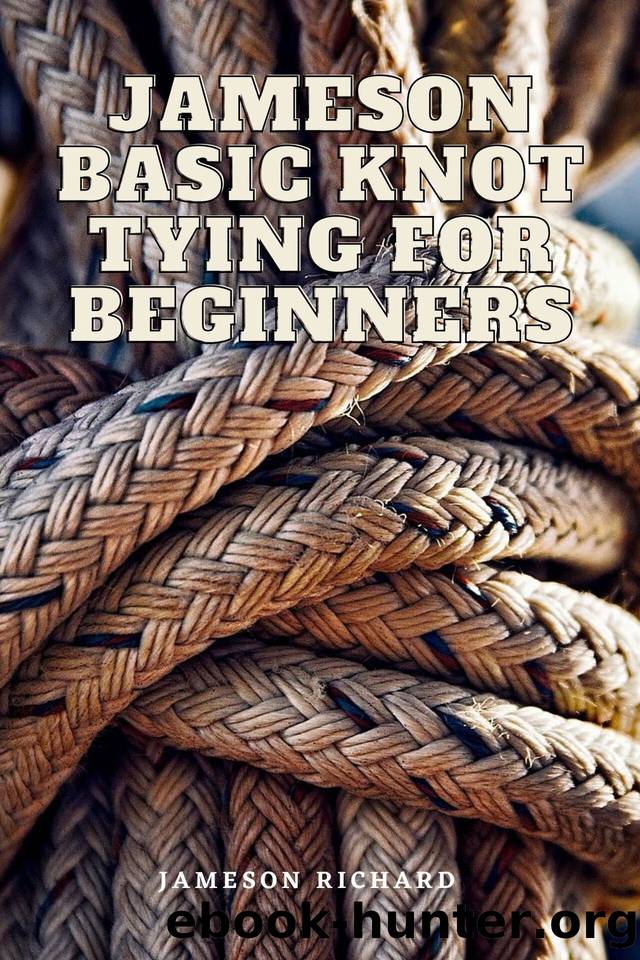JAMESON BASIC KNOT TYING FOR BEGINNERS: LEARN HOW TO TIE THE BASIC KNOTS FOR YOU DAILY USE ALL LAID DOWN WITH GRAPHIC ILLUSTRATIONS AND APPLICATIONS by JAMESON RICHARD

Author:JAMESON RICHARD [RICHARD, JAMESON]
Language: eng
Format: azw3
Published: 2020-08-12T16:00:00+00:00
RELEASABILITY
Knots contrast in the exertion required to loosen them in the wake of stacking. Bunches that are hard to loosen, for example, the water tie, are said to "jam" or be Jamming knots. Knots that come unfastened with less trouble, for example, the Zeppelin twist, are alluded to as "non-jamming".
TERMINOLOGIES IN KNOTS TYING
1. THE WORKING END
In knotting terms the end of the rope that is used to actually tie and form the knot is known as the Working End, such as the end used to tie a Figure of Eight Re-Threaded. The working end can also be referred to as the tag end, tag end or running end.
2. A BIGHT
A bight is a U-shaped section of rope usually used to tie knots on the bight. A knot tied on the bight will normally form a Loop-Knot.
3. THE CROSSING POINT
A crossing point is where the rope crosses itself, this will happen if we take a bight of rope and twist it to form a loop.
4. AN OVERHAND LOOP
Depending on which direction we twist a bight to form a loop, we will either end up with an overhand loop or an underhand loop. An overhand loop is created when the working end of the rope lies over the top of the standing part.
5. THE INTERLOCKING ELBOWS
Interlocking elbows occur when a bight of rope is twisted twice to form two crossing points. Knots such as the Alpine Butterfly are tied by firstly forming interlocking elbows.
6. AN UNDERHAND LOOP
If the standing part of the rope lies over the top of the working end, then an underhand loop is formed. An underhand loop is the opposite of the overhand loop.
7. THE STANDING PART
The standing part is the length of rope, cord or twine that lies between the working end and the standing end. If we were to abseil or rappel down a rope, we would attach to and descend down the standing part.
8. THE STANDING END
The standing end is the opposite of the working or tag end of the rope. When abseiling or rappelling this would be the end of the rope that we send down to the ground or landing point. Never forget to tie a stopper knot near the standing end, even if the ropes do touch the ground or landing point.
9. TURN
This is one round of a rope on either a pin or cleat.
10. LASHING
The arrangement of ropes used to secure different items together.
11. FLAKE
This refers to the number of turns in a coiled rope.
12. HITCH
This is a knot that attaches a rope to an object
13. JAMMING KNOT
Download
This site does not store any files on its server. We only index and link to content provided by other sites. Please contact the content providers to delete copyright contents if any and email us, we'll remove relevant links or contents immediately.
Big Boys' Rules by Mark Urban(482)
Resistance band Training: A Resistance Bands Book For Exercise At Home Or On The Go. by Atkinson James(446)
Saving the World and Other Extreme Sports: A Maximum Ride Novel by James Patterson(430)
Training for the New Alpinism by Steve House Scott Johnston Mark Twight(393)
Idiot's Guides - Krav Maga by Kevin Lewis & David Michael Gilbertson(380)
To Hell and Back by Niki Lauda(336)
The College Football Problem by Rick Telander(331)
Woodlawn by Todd Gerelds(316)
Sports Biomechanics by Blazevich Anthony(303)
The Science of Car Racing (The Science of Speed) by Karen Latchana Kenney(302)
Survival by Navy Seal Workout(301)
The Goalkeeper's History of Britain (text only) by Peter Chapman(299)
The Cleveland Way by Alan Staniforth(273)
American Krav Maga by Mark Slane(269)
THE HISTORY OF FORMULA 1 TO THE RHYTHM OF FAST LAP: 1950-2020 Travel back in time with Ferrari, Fangio, Williams, Prost, Senna, McLaren, Alonso, Mercedes... by Charles Sanz(267)
Open Net by George Plimpton(265)
Take Your Eye Off the Ball 2.0: How to Watch Football by Knowing Where to Look by Pat Kirwan & David Seigerman(260)
Separate Games by David K. Wiggins(258)
Hadaka-Jime: The Core Technique for Practical Unarmed Combat by Moshe Feldenkrais(254)
